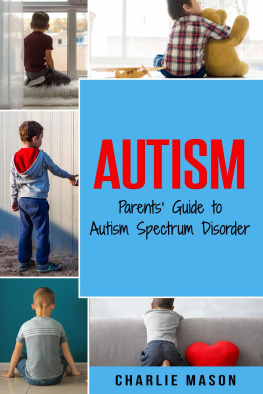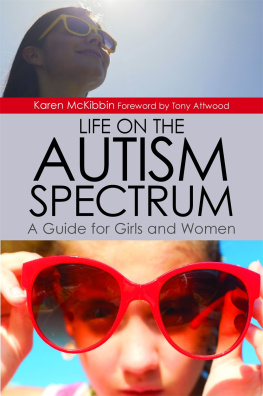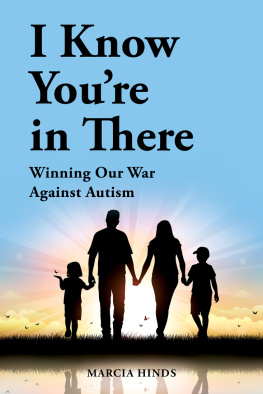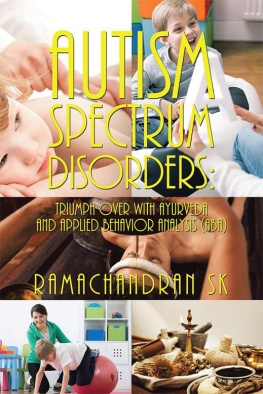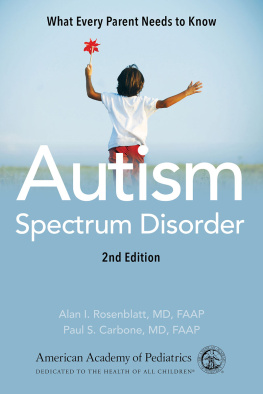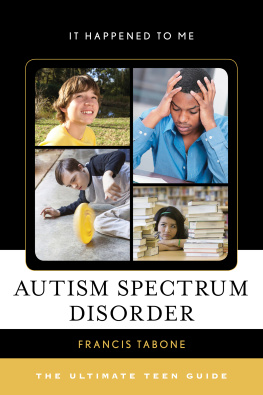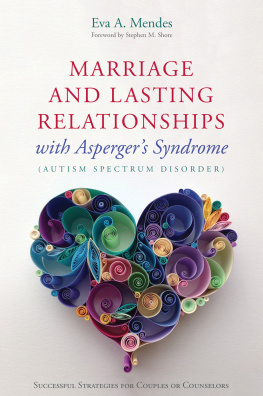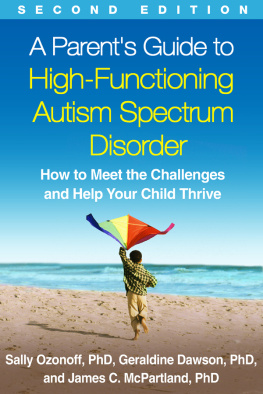
Stephen Heydts love, respect and understanding of children on the autism spectrum shines through in this easily accessible book. It is a veritable cornucopia of all things pertaining to autism. Scrupulously researched, it makes finding information on all aspects of autism as easy as ABC.
A book that is Accessible, Beneficial and Convenient, that should grace the shelves of all those who are eager to know more about this enigmatic condition.
K. I. Al-Ghani, specialist advisory teacher, university lecturer, autism trainer and international author of books on ASD
Each childs different qualities enrich us all, Stephen Heydt reminds readers in this brief but reassuring, wide-ranging guide. Practical and accessible, A Parents ABC of the Autism Spectrum offers sympathetic, clear definitions, concise explanations, and thoughtful strategies for how we can best support our children with ASD.
Liane Kupferberg Carter, author of Ketchup is My Favorite Vegetable: A Family Grows Up with Autism
of related interest
A Beginners Guide to Autism Spectrum Disorders
Essential Information for Parents and Professionals
Paul G. Taylor
ISBN 978 1 84905 233 7
eISBN 978 0 85700 477 2
My Child Has Autism, Now What?
10 Steps to Get You Started
Susan Larson Kidd
ISBN 978 1 84905 841 4
eISBN 978 0 85700 349 2
Can I tell you about Autism?
A guide for friends, family and professionals
Jude Welton
Illustrated by Jane Telford
ISBN 978 1 84905 453 9
eISBN 978 0 85700 829 9
Part of the Can I tell you about? Series
Can I tell you about Asperger Syndrome?
A guide for friends and family
Jude Welton
Illustrated by Jane Telford
ISBN 978 1 84310 206 9
eISBN 978 1 84642 422 9
Part of the Can I tell you about? Series
A Parents
ABC of the
Autism
Spectrum
Stephen Heydt

Jessica Kingsley Publishers
London and Philadelphia
First published in 2017
by Jessica Kingsley Publishers
73 Collier Street
London N1 9BE, UK
and
400 Market Street, Suite 400
Philadelphia, PA 19106, USA
www.jkp.com
Copyright Stephen Heydt 2017
All rights reserved. No part of this publication may be reproduced in any material form (including photocopying, storing in any medium by electronic means or transmitting) without the written permission of the copyright owner except in accordance with the provisions of the law or under terms of a licence issued in the UK by the Copyright Licensing Agency Ltd, www.cla.co.uk or in overseas territories by the relevant reproduction rights organisation, for details see www.ifrro.org. Applications for the copyright owners written permission to reproduce any part of this publication should be addressed to the publisher.
Warning: The doing of an unauthorised act in relation to a copyright work may result in both a civil claim for damages and criminal prosecution.
Names: Heydt, Stephen, author.
Title: A Parents ABC of the Autism Spectrum / Stephen Heydt.
Description: London ; Philadelphia : Jessica Kingsley Publishers, 2017. | Includes index.
Identifiers: LCCN 2016028295 | ISBN 9781785921643 (alk. paper)
Subjects: LCSH: Autism in children. | Autistic children--Care. | Parents of autistic children.
Classification: LCC RJ506.A9 H495 2017 | DDC 618.92/85882--dc23 LC record available at https://lccn.loc.gov/2016028295
A CIP catalogue record for this book is available from the British Library
ISBN 978 1 78592 164 3
eISBN 978 1 78450 435 9
FOR PARENTS
There are no perfect parents.
For most children,
their parents are perfect.
Contents
For Parents
(Note: The terms autism, ASD and spectrum all have the same meaning in this book.)
This book contains wide-ranging information about children with Autism Spectrum Disorder. Every child with ASD is different, so while each subject will relate to some child, it may not be relevant to your child or any you may know or have met in the past. Throughout this book is information about children with ASD and the different ways in which they may think, feel and behave. The behaviour of different children and of any one child will vary, at times, from being unremarkable to being quite disruptive in any context, whether at home, school or in public. While a particular difficulty of the child may not be obvious and they may not have sufficient awareness of the difficulty or the communication skills for them to identify it to others, it does not mean that it is not present. For example, people with synaesthesia, an unusual and most interesting neurological condition with seldom any adverse consequences, do not realise until they talk about their own experiences that most people dont perceive a middle C in music as violet and B flat as smelling as roses or perhaps the letter H as pink and Q as tasting like nutmeg. This particular neurological difference is typically only diagnosed in adults, because children just dont realise that their sensations are any different from anyone elses. Similarly, when one person describes that they are anxious without clarifying they are scared of spiders, another person anxious at writing exams may make an incorrect assumption.
It is particularly important for children with ASD to have regular physical check-ups. Eyes, ears, sinuses, teeth, joints and stomachs should be examined at least every six months by an understanding and patient practitioner. Before any first visit by a child with ASD, parents should first have a discussion with the primary carer. For some reason, perhaps sensory insensitivity or high pain threshold, experience suggests that children with ASD do not seem to receive medical attention as quickly as their peers. Some individual examples: a child with chronic head-banging behaviour was found to have a badly rotten tooth, another with noise sensitivity had a middle ear infection, and a sweet ten-year-old had embarrassing public groin-grasping behaviour due, it was discovered, to a urinary tract infection.
This book is written from the perspective that any child, and all children with ASD, is as near perfect as humans can be. In much the same way as microscopic and sometimes significant differences add lustre or character, respectively, to the most beautiful diamonds, each childs different qualities enrich us all. In diamonds these differences are appropriately called inclusions. Parents are little different from master diamond cutters; by working around the inclusions, with careful polishing and what in diamond cutting is marvellously called brillianteering, in their hands the most breath-taking jewels can emerge. Sadly, sometimes our inviolable systems of education shatter the jewel and leave it in a thousand pieces for someone else to attempt the repair. This book is written to assist you in forming those unique jewels.
This book gives some ideas that can be, and are recommended to you to be, implemented by you or with professional assistance when indicated. Individual approaches are essential, and not merely desirable. Always discuss and practise techniques with other adults; and have those that are significant in the childs life agree to a common approach before implementing with any children and, in particular, those with ASD. You will usually only have one chance to get it right, after which children will be deeply suspicious or experience anticipatory anxiety. Always seek additional advice and help, as children with ASD are particularly different from one another and typical children in their abilities and functioning. What works with one child may only ever work with that one child and sometimes only for one day.
Next page




